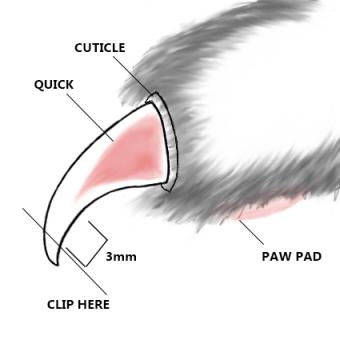
Some people make trimming their cat's nails look like a piece of cake, but if you’re a new cat owner or your feline friend isn’t very cooperative, it might feel more like a WWE match. Understanding how to trim your cat’s nails (and discovering our tried-and-true tips) can help you feel confident with the process. No scratches or screaming involved.
How to Trim Your Cat's Nails
The actual process of trimming nails is fairly straightforward, but it requires the right tools, a lot of practice, and some cooperation from your cat to accomplish it.
Supplies
- The nail trimmer of your choice
- Nail file, optional
- Styptic powder to stop any bleeding
If you don't have styptic powder, corn starch can work in a pinch.
Directions
- Hold your cat in your lap with their paws facing away from you and work on one paw at a time.
- With one hand, pick up the first paw and gently press the top of one toe and the corresponding pad at the bottom to expose the nail.
- Locate the pink center of the nail, known as the quick, which is the nail's blood supply. You must avoid cutting it or you'll cause pain and bleeding. Plan to trim roughly halfway between the sharp nail tip and the quick.
- Holding your trimmers in your opposite hand, cut off the sharp tip of the claw. File any rough edges smooth using light strokes.
- Repeat the process with each claw you trim.

It's helpful to have a little styptic powder in the lid of its container nearby in case you cut a quick. To stop any bleeding, dip the injured nail in the powder and apply gentle pressure.
Tips to Make Cat Nail Trims Easier
Does your cat put up a fight anytime you get the trimmers out? You’re not alone. Teaching a cat to accept nail trimming is easier if you begin when they're a young kitten, but that doesn't mean you can't teach an older cat new tricks. You might find these tips helpful in teaching your cat to tolerate nail trimming.
- Condition them to handling. It definitely takes time to condition your cat to having their paws handled, and you'll want to do this before you even attempt to trim their claws. Work on one paw or even just one or two toes at a time.
- Grab a helper. It's often easier to have another adult hold the cat for you. This will free you up to just concentrate on trimming the claws.
- Use a towel wrap. Gently wrapping your cat's body in a towel can help you restrain them during their nail trim. Just stick one foot out at a time and keep the others confined within the towel.
- Consider the timing. Trimming is often easier when your cat is tired, so plan on doing it when they're relaxed and sleepy, like right after dinner. That should make them easier to handle.
- Use sharp trimmers. Always use sharp trimmers, no matter which style you use. Sharp trimmers make a clean cut, while dull trimmers make a ragged or only partial cut.
- Go at their pace. You don't have to trim all your pet's claws at once. You can trim a few claws at a time over the course of several days if you have to. The key is to avoid overstressing your cat to the point that they feel the need to avoid you when you have your trimmers in hand.
- Reward them. Reward your cat frequently during the trimming process. A little lick of tuna or some other favorite morsel can eventually make them happy to cooperate.
If your cat attempts to bite you, becomes aggressive, or appears stressed at any point, stop. You don't want to make the experience a negative one or put either of you in harm's way.
Selecting a Nail Trimmer
There are several types of trimmers you can use, which can be a little overwhelming at first. Each has its strengths and quirks, but ultimately, it comes down to your personal preference.
 | These standard nail clippers (yep, the ones you use on yourself!) can work well for cats. Snip off the sharp nail tips. However, if the edges of the clipper are even slightly dull, they tend to shatter an adult cat's claws and leave a ragged edge. |
 | The name sounds a little morbid, but with these trimmers, you place your cat's nail through the opening and then press the handles to make the blade slide through the nail and cut it. The main drawback is that it's a little difficult to keep track of where the quick is with this type of trimmer, which can be a real problem if your cat suddenly moves their foot while you're trimming. |
 | You can use scissor trimmers on kittens and adult cats alike. As long as they're sharp, you'll get a clean trim whether you hold them perpendicular or horizontally as you trim. You'll need to replace them when they get dull, but they can last a long time. |
When in Doubt, Leave It to the Pros
While it's definitely possible to cut your cat's nails at home, there's nothing wrong with asking your vet or groomer to take care of it for you. This is especially important if your cat is aggressive and could potentially injure you or themselves. Ask if you can watch how it's done and get personalized guidance on what your cat responds to best. Remember, every cat is different, and what works for one might not be ideal for another.







